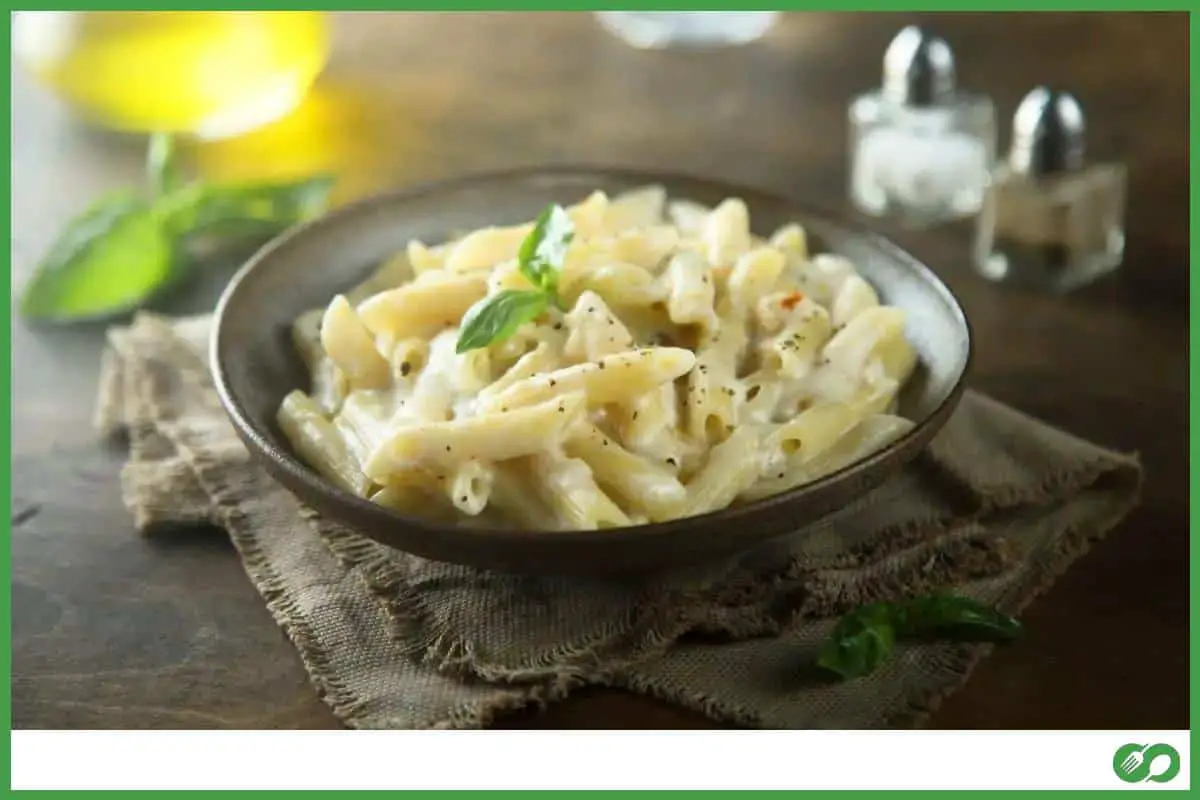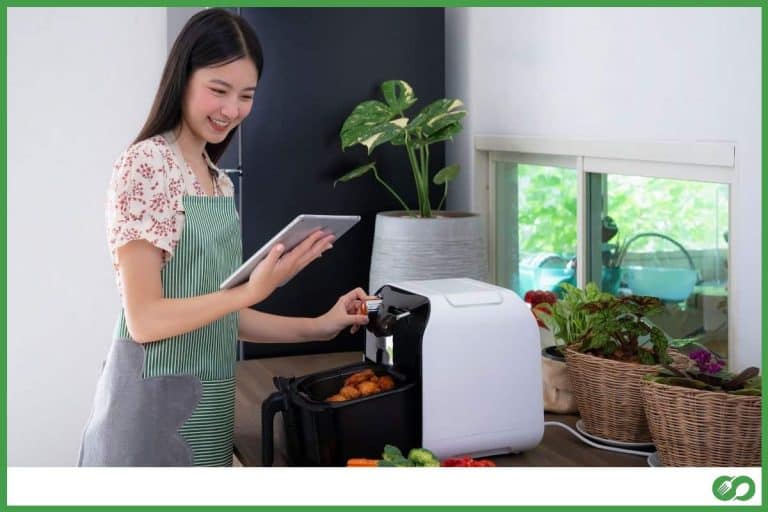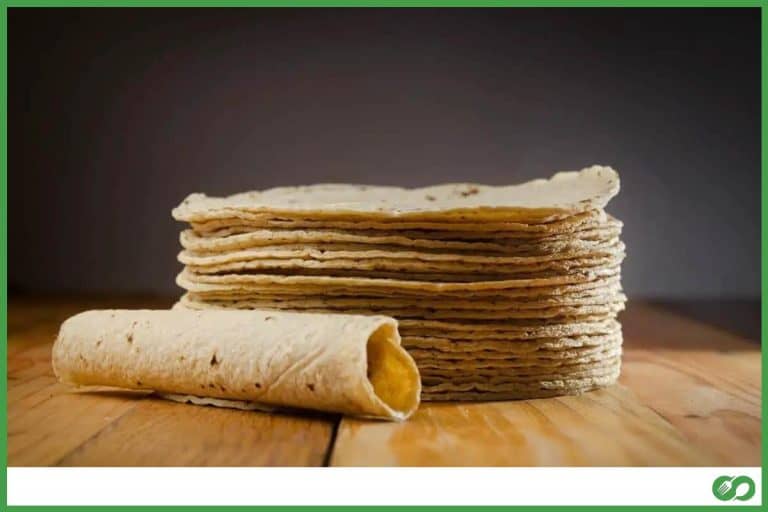How to Reheat Pasta with Cream Sauce?
This post may contain affiliate links which means that, if you choose to make a purchase, I may earn a small commission at no extra cost to you.
If you want to take a night off from cooking but do not want to miss out on homemade meals, leftover cream pasta is just a reheat away. But often the cream sauce splits or curdles while reheating. So, let’s find out how to reheat pasta with cream sauce without drying it out or splitting the sauce.
One of the best methods to reheat creamy pasta is to reheat it with some milk on a stove with high heat. To prevent the cream sauce from splitting, reheating on a stove with low heat would be best. Using a microwave, oven, or double boiler works well too.
Based on your convenience and the quantity of the pasta, one method might give the best result while the others might turn your pasta to mush. So, to help you get your best results, this article contains some dos and don’ts pertaining to reheating as well.
How Many Times Can You Reheat Pasta with Cream Sauce?
According to the Food Standards Agency, foods containing milk and sauces should not be reheated more than once. Because it is quite tricky to reheat such leftover dishes evenly. However, you still can reheat your pasta with cream sauce twice as long as you reheat it thoroughly.
I understand that it feels great to have nights off from cooking. But I suggest you not reheat the pasta more than twice. Otherwise, it will turn too mushy and curdled to fix. So just stick to reheating it twice.
Various Methods to Reheat Pasta with Cream Sauce
There are several ways to reheat creamy pasta. But if you do not follow the steps properly, it will be of no use to pour over extra cream sauce to make the leftover rich in flavor. Below here are some of the easiest methods:
- Double Boiler
- Microwaving
- Reheating on Stove with High Heat
- Reheating on Stove with Low Heat
- Reheating in the Oven
Double Boiler
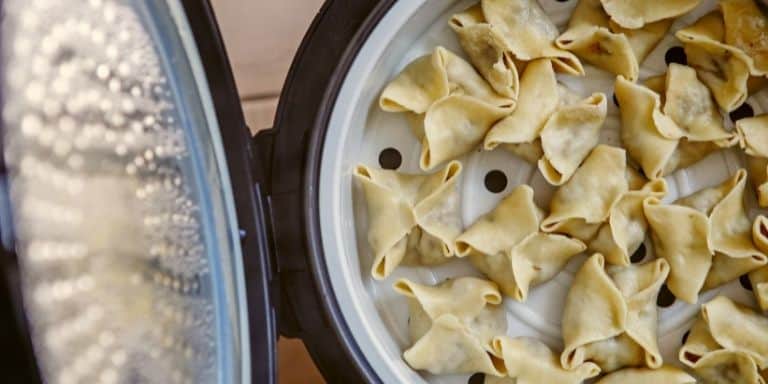
It’s a gentle and fast method for reheating pasta, especially Alfredo. All you will need is a double boiler, some milk, cream sauce, and water. If you do not have a double boiler, use a large saucepan and stainless steel bowl instead. And follow these steps
Step 1: Prepare the Double Boiler
If you have a double boiler, add 2 to 3 inches of water in the bottom pan. And bring the water to simmer at 180 degrees F on medium heat.
Once the water starts simmering, place the top pan over the bottom pan. If a double boiler is not available, fill 2 inches of water in a large saucepan. And in the simmering water place a stainless steel bowl. The water should not touch the top of the bowl.
Step 2: Place the Pasta
Place the creamy pasta in the bowl or top pan. Immediately, add two tablespoons of milk, water, and cream sauce to it. Let it sit there for a minute and get the heat from the simmering water.
If you think the leftover pasta has enough cream sauce, you can skip adding the extra cream sauce. But if it seems a little dry, add the sauce anyway. Also, it reduces the probability of the pasta getting clumpy.
Step 3: Stir and Serve
You should stir the pasta frequently. It will help it to soak the sauce evenly. After stirring it for two minutes, plate your pasta.
Microwaving
If you want to reheat pasta in large portions, microwaving is the method you should apply. Besides the microwave, you will need aluminum foil, a microwave-safe bowl or plate, a tray, water, and cream sauce (optional). Then the steps to follow include
Step 1: Arranging the Pasta
Arrange the pasta loosely in a large stainless bowl or plate. As you are reheating in large quantities, it is necessary to place it loosely. Otherwise, it will not even get heated properly.
You can either add some extra cream sauce or two tablespoons of water before placing it in the microwave. Now cover the bowl with aluminum foil.
Step 2: Place the Tray and Pasta
Add some water to a tray and keep the pasta bowl in the center of the tray. Now place the tray in the microwave. Microwave it on medium heat for three minutes.
The water will ensure a large portion of it gets heated evenly. And the foil paper is necessary to keep the reheated pasta moist. If foil paper is not available, you can use a leaf of romaine lettuce instead.
Step 3: Stir and Plate
You need to open the microwave after three minutes to stir the pasta with a fork. After stirring, microwave it for another one minute and then serve.
If you skip stirring, the cream sauce will not mix properly with the pasta. And some bites will be creamy whereas the others are bland.
On Stove with High Heat
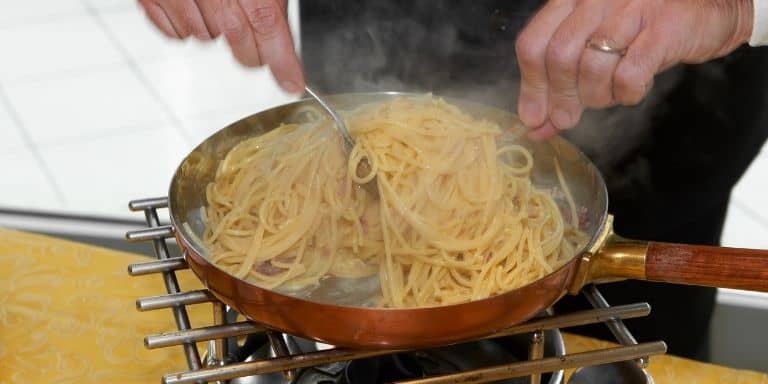
You need to be a bit careful with this method as you are using direct heat. You will only need two large pans, milk, and a spatula. Now follow these steps
Step 1: Simmer Milk and Split Sauce
In a large pan add 2-3 tablespoons of milk. You need to bring the milk to a simmer on high heat.
Before the milk comes to a simmer, on a different pan warm the pasta on high heat for about 30 seconds. This will loosen up the cream sauce from the pasta. And this split of cream sauce is necessary at this point.
Step 2: Stir and Mix
When the milk simmers, add the warm pasta to the milk. And the heat should be high at this point too.
As soon as you add the pasta, take a spatula and stir the dish continuously until the pasta soaks the milk. At this point, the split cream sauce will re-emulsify and coat the pasta. Now turn off the heat and serve.
On Stove with Low Heat
If you think you cannot take risks with high heat, then this method is for you. You need a saucepan, spatula, and milk or cream sauce to follow these steps
Step 1: Add Milk and Pasta
Keep a saucepan on the stove at low heat. Then immediately add a tablespoon of cream sauce or milk and pasta together. On low heat, warm it for about 4 minutes. And bring it to a sauce-like consistency.
Step 2: Stir and Loosen the Pasta
In this method, it is necessary to loosen the pasta. For that, take a spatula and stir the dish in a circular motion.
Once the pasta loosens up a bit, start folding in or mixing the liquid thoroughly for about 2 minutes. Once the sauce blends properly, you can serve the dish.
In Oven
Unlike a microwave, you do not need to create a bain-marie or keep a water tray in the oven. It’s a bit slower process than the others but requires less effort. Get an oven-safe shallow bowl, metal lid, some cream sauce to follow these steps
Step 1: Preheat and Arrange
Preheat the oven at 350 degrees F. And place your pasta in an ovenproof shallow bowl. If you want you can add some extra cream sauce to the creamy leftover pasta.
Once the oven preheats, place the bowl inside and cover it with a metal lid. It will not dry up your pasta. Now, bake it for 5 to 6 minutes.
Step 2: Stir and Bake
When the baking is at the 5 minutes mark, turn off the oven and stir the pasta. It helps to reach heat evenly and re-emulsify the cream sauce.
After stirring, bake the dish for 6 minutes more. And then it is ready to serve.
Tips On Reheating Creamy Pasta
As a huge pasta lover, I’ve reheated a lot of it in my life. Leftover pasta is frequent in my house. So, you can say I have a few tips to share that will ensure your reheated pasta is as close as possible to a fresh batch.
- If you use a nonstick pan, never use a metal utensil to stir the pasta. Otherwise, it will form clumps in the sauce easily.
- If you plan to eat the pasta a few minutes after reheating, you should never let it sit as it is. You should cover it up with a little butter. The butter will keep the cream sauce clinging to the pasta evenly. Otherwise, the sauce will curdle after a few minutes.
- Whether you are reheating in the oven or microwave, always turn off the timer one minute before the suggested time. Undercooked pasta can taste like Al dente (firm to the bite). But if you overcook, it will taste all mushy.
Conclusion
As a pasta lover when you twirl some reheated pasta around the fork, you definitely want the cream sauce to cling to it. And to get that, you need to understand how to reheat pasta with cream sauce properly without overcooking it.
Follow the tips and methods mentioned above and you can be sure it will be as good as a fresh batch every time.

